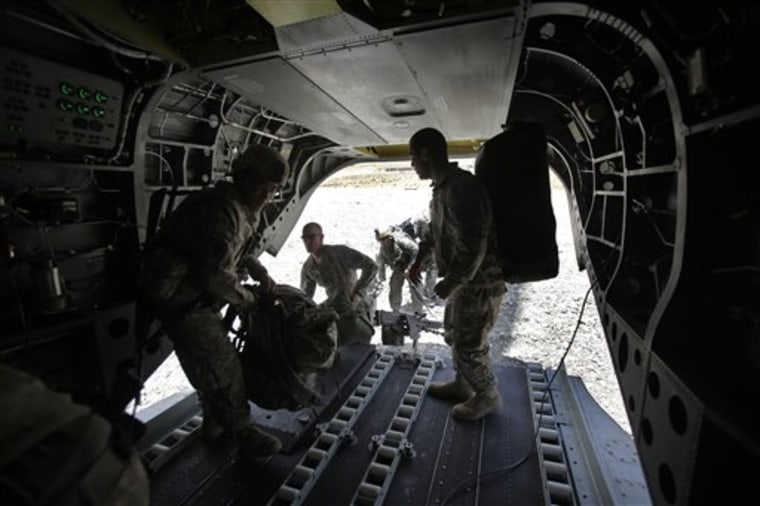A U.S. military investigation has found that American forces failed to follow proper procedures regarding offensive and defensive operations when they launched an airstrike that killed dozens of civilians in Afghanistan last month.
Pentagon and military officials tell NBC News the forces may not have been adequately trained in the more stringent procedures required to avoid civilian casualties in offensive airstrikes in Afghanistan.
The report detailing those training problems has not yet been made public.
In what's become an increasingly divisive issue over civilian casualties between the U.S. and Afghanistan, Afghan government officials claim as many as 147 civilians were killed in the May 4 airstrike. The U.S. investigations claims the bombing killed as many as 30 civilians and 65 Taliban fighters.
The incident occured when U.S. Marines and Afghan military forces came under heavy fire from an estimated 200 to 300 Taliban fighters in the Farah province of western Afghanistan.
The Marines called in defensive airstrikes from two U.S. Navy F-18 fighter jets, which bombed the Taliban positions. Sometime after the firefight had ended, gun camera video from a U.S. Air Force B-1 bomber had identified what appeared to be a large number of Taliban fighters regrouping outside a building at a nearby compound.
Building contained civilians
The B-1 then dropped a 2,000-pound bomb leveling the building, which was later determined to contain dozens of civilians. U.S. military officials claim the Taliban had herded the civilians into the building to be used as human shields.
The problem, according to military officials, is that what started as a "defensive operation" to protect the Marines under fire, rapidly turned into an "offensive operation" against a seperate target sometime after the firefight was over, causing the rules change.
"If our guys are under fire and call for air cover, that's one thing, but once the shooting stops and it becomes an offensive operation you'd better be sure you know what's inside the building," said one official. In addition, one military official called the use of a 2,000-pound bomb against the target inside a small compound, "overkill."
Without revealing those details, Pentagon spokesman Geoff Morrell told reporters last week that "there were some problems with the tactics, techniques and procedures" and in "the way in which close air support was supposed to have been executed."
Officials said the report does not recommend changes in tactics and procedures used in Afghanistan, though the new commander there, Gen. Stanley McChrystal, has said he will review them as well as all existing rules of engagement.
Military commanders have previously reviewed and rewritten such guidelines — including those on bombing missions and on how special forces operate — in an effort to avoid Afghan casualties.
Thousands of troops on their way
The Obama administration is sending 21,000 troops to Afghanistan to bolster the nearly 8-year-old campaign. That will bring the total foreign force there to some 68,000 Americans and 33,000 allied NATO forces by the end of the year.
Defense Secretary Robert Gates and other top military officials have said that reducing civilian deaths is crucial to winning Afghan support for American and coalition operations against the insurgents and boosting the population's support for the central government.
Canadian Brig. Gen. Richard Blanchette, a spokesman for NATO forces in Afghanistan, said the review will help international forces improve their operations.
"This will close the loop of what needs to be done to have the right kind of learning process," Blanchette told The Associated Press in an interview from Kabul.
Blanchette also said, as a number of commanders have, that some of the deaths in Afghanistan are the direct result of the insurgents' intentional practice of hiding among civilians. He said using civilians as human shields is designed "to discredit the action of our forces," and making the jobs of young field commanders "very tough" when they have to call for close air support.
He declined to comment specifically on the report because it hasn't been released.
Defense officials have struggled for days to produce an unclassified summary that can be released publicly and would explain the findings of the investigation. They have also worked to pare down hours of video that shows what happened.
Civilian death toll fueling resentment
The overall civilian death toll in the war has not only fed Afghan resentment toward the military mission but also become a major irritant in U.S. dealings with Afghanistan's fragile civilian government. Protecting the population is key to the counterinsurgency campaign.
The United Nations has said 2,118 civilians died in the Afghan war last year, 40 percent more than in 2007. The U.S., NATO and Afghan forces killed 829 civilians, or 39 percent of the total, the U.N. said. Of those, 552 deaths were blamed on airstrikes.
The Pentagon says that in the first five months of this year, civilian casualties have dropped 27 percent from the same period in 2008, and that kidnappings and assassinations decreased 19 percent. At the same time casualties among U.S. and NATO forces have risen 62 percent, the Defense Department says. It does not release exact figures, but officials say the increase in military deaths comes as troops venture into areas where they have not been before and so engage more with insurgents.
According to the U.S. military, the battle in Farah province began a day after Taliban fighters entered two villages, demanded money from civilians and killed three former government employees. An Afghan force rushed in, only to be ambushed by as many as 300 insurgents.
The provincial governor asked for U.S. military help, and American ground troops joined the battle, the U.S. officials said. Before the battle was over, troops called in F-18 fighter jet airstrikes as well as help from the B-1, coordinating with the ground commander to strike a half-dozen targets, including buildings and a tree grove that insurgents were firing from or massing in, the U.S. has said.
